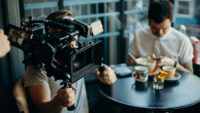After months of shutdown, film and television production is reviving in two countries that have successfully flattened the curve. Producer Lucas Foster isolated his cast and crew in a small Australia town to shoot Stephen King’s “Children of the Corn.” Icelandic director Baltasar Kormakur used color-coded armbands to shoot Netflix sci-fi series “Katla” in Reykjavik. Going back to production in the time of coronavirus isn’t easy, and requires security guards to monitor social distancing, medical staff and other strict protocols.
The New York Times reports that, in March, Kormakur began work on the eight-episode supernatural drama on a “50,000-square-foot soundstage that he owns,” but the government shut down the country — and the production.

Quarantined at home, he created a color-coded armband system: “those wearing yellow could be near the camera; the actors, and the makeup and costume professionals wore black and spent most of their prep time in a cordoned-off area of the set; and the producers, script supervisors and visual effects people wore red and were sequestered near the monitors.” A few wore blue armbands that gave them access to all areas. No group had more than 20 people.
Iceland also has “rigorous testing policies,” and Netflix executives both tested Kormakur’s method and “financed the extra costs associated with the safety protocols and paid the cast and crews’ salaries when they were shut down.” Everyone entering the set had their temperature scanned, were served boxed meals, and “most everyone except the actors wore masks, and the makeup artists and production designers were gloved.”
No director, including Kormakur, however has “yet to try a scene involving any close contact or intimacy.” Now, “Kormakur and the Iceland government are looking at bringing foreign crews into the country to bolster production.”
Foster also divided his set by job function, and “a nurse, a paramedic and a doctor were present daily.” Cast and crew fill out wellness questionnaires at the beginning and end of each day and have their temperatures checked. In one challenging night sequence, “the actors were dressed in neoprene suits both to keep them warm and to offer them another level of protection when they came in close contact during the scene.”
For 80 days, Foster isolated with in the same location with “his entire cast and crew together, including the guardians for more than 25 child actors … [and] an actor’s dog.” Foster reported that, “the extra precautions added at least 20 percent to the initial $10 million budget of his indie film.”
Foster also had to deal with a “shortened shooting schedule because of the usual restrictions placed on minors, navigated the stress levels of a disparate crew and found replacement actors when a few dropped out at the last minute.” “There is no cheat sheet for this,” he said. “Retraining on the job has been the most challenging thing.”
Related:
After the Coronavirus, the Race to Resume Film Production Goes Global, The Los Angeles Times, 5/18/20
How Baltasar Kormakur Re-Started Production on Netflix’s ‘Katla’ Amid COVID-19 Lockdown in Iceland, Deadline, 5/1/20
How Do TV Shows Handle Remote Production? With Mailed iPhones and Hazmat Suits, for Starters, The Washington Post, 5/4/20
Pandemic Lockdown Halts Hudson Valley’s Booming Film Industry, The New York Times, 5/19/20
COVID-19 Safety Coordinators Should Be New Reality, Proposed Guidelines Say, Deadline, 5/14/20
Will Prohibitive Insurance Hobble Production Restart & Will Government Have To Step In?, Deadline, 5/15/20

No Comments Yet
You can be the first to comment!
Sorry, comments for this entry are closed at this time.